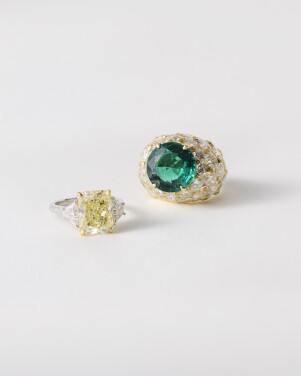T here are few names more universally known than those of the great jewelry houses: Cartier, Van Cleef & Arpels, Tiffany & Co., Bulgari. These venerable designers are simply synonymous with craftsmanship, beauty and – let’s be frank – bold, glittering gemstones. Generations of men and women have learned what a gift of a small red box might mean, how to identify a Serpenti, or that anything resembling the form of the Alhambra makes for a perfect demonstration of luck and good fortune.
Centuries of expertise means this appreciation runs deep and won’t be going away any time soon. But could a new star be rising in the world of gemstones and jewelry? One that won’t displace its formidable forbears, but complement them? Gen Z certainly seems to think so.
The fact is, unbranded gemstones of high quality are rising in popularity among young consumers worldwide. This may surprise those who’ve been taught that young people love labels, hype brands and the status of social media. Certainly, this stereotype goes, Gen Z are a clear target for that material. But they are also an audience that is increasingly looking beyond the label.
“The iconic pieces that really showcase high houses remain sought after,” says Emma Paleschi, the London-based Managing Director for Global Jewels and Fashion in Sotheby’s Jewelry Department. But she and her team have noticed a new trend: “Younger audiences are becoming more active in our sales and they’re not just only looking to Cartier, Van Cleef & Arpels, Bulgari, et al. They have a wider, more dynamic curiosity about jewelry.”
In response, Sotheby’s Sealed is initiating The Gem Drop, a monthly release of three high-quality gemstones priced between $20,000-120,000 and sold loose or very simply mounted. Each is hand picked by a Sotheby’s specialist with access to top sources, ensuring the best quality and pricing.

People of all ages love a classic white diamond. But recently, the Sotheby’s Jewelry teams have seen spiking in interest from younger clients, for objects like colored diamonds and gems – usually a higher price point typically inhabited by a more discerning buyer. Today, unsigned jewel sales to Gen Z clients have grown +344% year on year. That is one serious spike.
“I wasn’t expecting to see a younger consumer be so active in our sales around that type of property,” says Paleschi. “It requires much more knowledge.”
Knowledge might just be the reason that young buyers have gained an edge in this market. Social media provides nearly endless inspiration, aspiration and trend mapping – not to mention more direct access to experts. Take Emily Ratajkowski, who, when divorcing her ex-husband, ripped apart her two-stone engagement ring and repurposed the diamonds into “divorce rings” with the help of a jeweler friend – then took to Instagram to show off the final products. More recently, Hailey Bieber told followers that, thanks to her pregnancy, her original engagement ring no longer fit on her ring finger. She’s moved it to her pinky and is now sporting a brand-new diamond.
Paleschi calls this the “upgrade phenomenon,” or the process of repurposing or completely swapping out jewelry as the owners achieve different milestones in their lives. “When you think about someone between the ages of 20 and 40,” she says, “within that period there are generally many moments to celebrate. As a person grows over the years, their tastes, style and financial situation grows too. So the style you chose – or that was chosen for you – for your engagement ring might be very different from the jewelry you want to wear 10 years later.”

Shop Diamond Bracelets, Earrings, Rings and Pendants
“Younger audiences are becoming more active in our sales. … They have a wider curiosity about jewelry.”
Other milestones (buying a house, having a baby, getting a promotion) don’t have clear cultural connections to jewelry. That’s when loose or unbranded gems become a particularly perfect first step in gifting – you can transform unbranded stones into a piece that is personal and specialized for you. Selling stones in simple settings, Sotheby’s can recommend a designer or a workshop to buyers – or even work directly with the client to transform the piece in-house.
And remember: what you lose in brand name value when purchasing an unbranded stone, you gain in pure value. “You are placing all of your spend in the stone,” says Paleschi, “and it’s a great opportunity to personalize.”
Which brings us back to the generational aspect of this trend. Gen Z is the most technologically savvy generation alive today – they were practically born with iPhones in their hands. It stands to reason that they know what they want and exactly how to get it. Yes, they’re still buying brand names because they know that, as Paleschi says, “a piece of jewelry with a signature from a great house will always carry its value.” But they’re also being creative, taking the time to find inspiration and rewarding themselves for accomplishments. It’s a lesson that collectors from every generation have taken the time to learn.

















